7 Ways to Adapt Your Home for those with Low Vision
People with sight loss need to feel comfortable, safe, and completely in charge of their surroundings.

The first rule to remember is that vision loss is a spectrum. their vision loss and their accommodations will vary widely from person to person. Some prefer dark spaces as brightness hurts their eyes while others require brightness to see "clearly".
This is a generic guide that covers as many pointers as possible, applicable across the board. But the first choice always belongs to the person with the vision loss - ask them what's best for them.
1. Lighting
One of the best things that makes a huge impact is lighting.
Making a few changes to illuminate space is to think where one needs to see clearly:
- Changing the placement of light fixtures can also help better illuminate dark spaces.
- Bright bulbs for potentially hazardous areas such as the bathroom, kitchen, and stairways.
- Lights should be set behind seats for television viewing to prevent glare.
- Use small portable lamps for detail work areas such as kitchen counters (for chopping and food prep), next to the chair for reading, and crafts.
- Brighten your outdoor pathways at night by using motion-detection floodlights and solar lights along the pathway.
2. Interior Design
When changing interior design, you should think of contrast - light colors against dark backgrounds and vice versa; and minimalizing - keeping everything clutter-free and less busy.
These two things will help with seeing things - they'll pop out and be easy to see and locate:
- Paint the baseboard and door jambs around the room a contrasting color from the floor and wall for visual guidance while moving about.
- Some vision loss websites suggest padding sharp edges such as tables. Please don't do this. Do not infantilize those with vision loss. I bet they already shuffle around slowly anyway. You can put a contrasting colored tablecloth on the table instead.
- Furnishings should be lighter or darker than the floor's color. If this isn't feasible - use a throw blanket on the couch or chairs.
Look at this Living Room, it's a nice bright design.
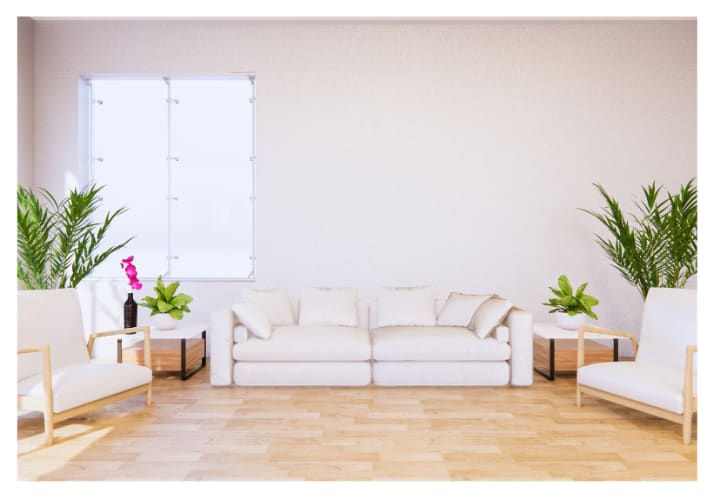
But, this is what it may look like to someone with low vision.
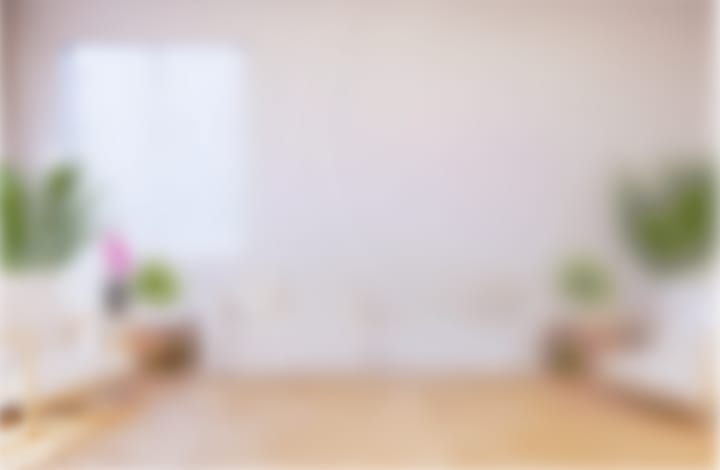
Can you find the couch now? How about if we put a colorful blanket and pillows on the couch and chairs?
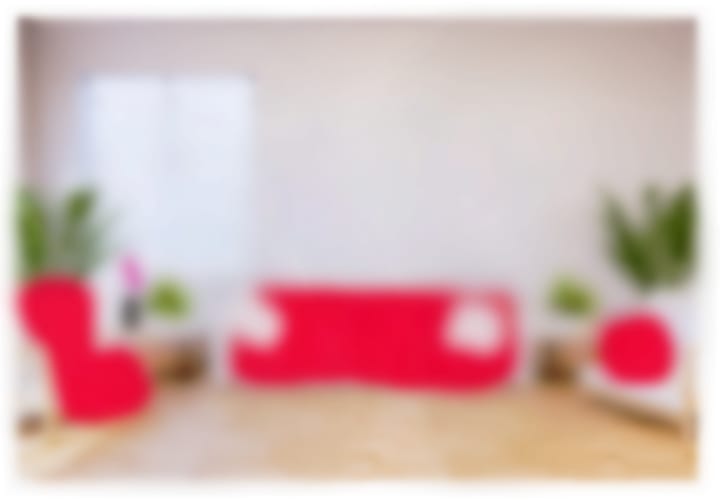
Much better isn't it?
- Switch out the light switch plate for a contrasting color to make its location easier.

3. Appliances
Many new appliances are either touch-screen or have flat buttons that are hard to identify by touch.
There are several ways to alleviate this:
- Use tactile dots - put these tiny dots on the most used buttons. I use them on my microwave on the Start, Stop, and the #5 buttons. Why only the #5 button and not each number? I locate the #5, then I can move up for #2, left for #4, right for #6, and so on.
- Use Puffy Paint - I draw small lines on the dials of my oven, washer, and dryer. A tactile dot can also be placed on the frequently used setting - like the 350° setting. Simply align the tactile line with the tactile dot to set the oven or stove. This eliminates the need to lean over a hot stove to see the dials.
4. Kitchen
According to statistics, the kitchen is where accidents are most likely to happen - now factor in vision loss, and this number can increase significantly.
Here are some tips for making your kitchen safer:
- To keep countertop appliance cords tidy and prevent accidental use, plug them all into a power strip and turn it off when you're finished.
- Use contrasting-colored cutting boards. White for dark-colored foods like broccoli, dark meat, and tomatoes. Black for onions, chicken, and cauliflower. NOTE: Please do not cross-contaminate raw meats and other foods.
- There are also other safety adaptations that can be used while cutting and chopping. Such as a knife guard to wear on your fingers; an adapted cutting board with a hinged knife; or a manual food chopper.
- Avoid using pot lids to drain foods. Instead, obtain a large colander for the sink and pour everything into it. This trick can also be used to drain grease from food. Use a large empty coffee tin and a strainer that fits on the top. Scrape all the meat into the strainer and let it drip for a bit.
- Use Echo Show for many visual adaptations. Did you know the Echo Show can read boxes and can labels aloud to you?
- The writing on many measuring cups and spoons fades over time making identification almost impossible. With these shaped ones it is possible to identify the size upon sight or touch.
5. Bathroom
The bathroom is the second most dangerous room in the house - let's make sure it's safe for vision loss:
- Get talking prescription tags for medication bottles. This is available at most Pharmacies now. An app on the phone will read aloud your prescription bottle.
- Use contrasting color rubber non-slip mats in bathtubs and showers for a place to aim your step.
- Use contrasting colored floor mats up against the tub and shower as a visual boundary.
- Grab bars in the tub and shower can be especially helpful for people with vision loss, who may move more slowly and need something to hold on to for stability
Let's do another vision test:
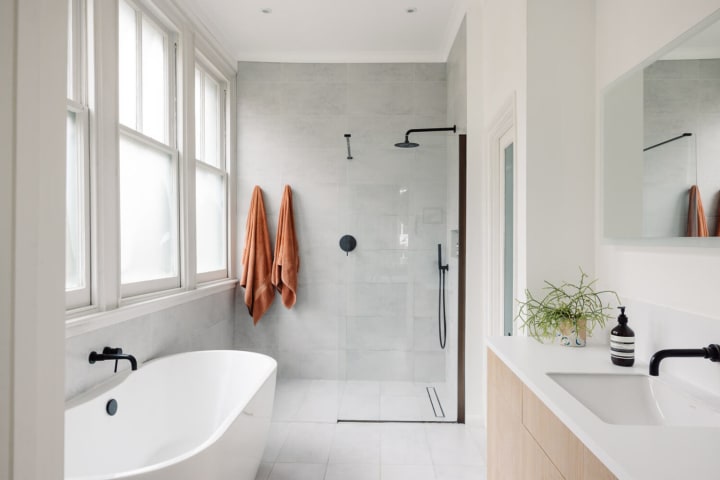
Notice the contrasting color fixtures? This is a bonus! Now let's see what it may look like with vision loss:
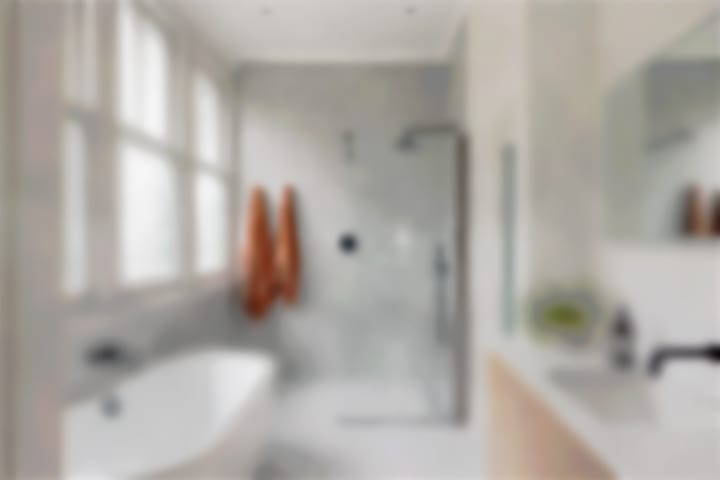
You can barely see where the tub begins, nor see the glass shower door. Let's add some safety adaptations:
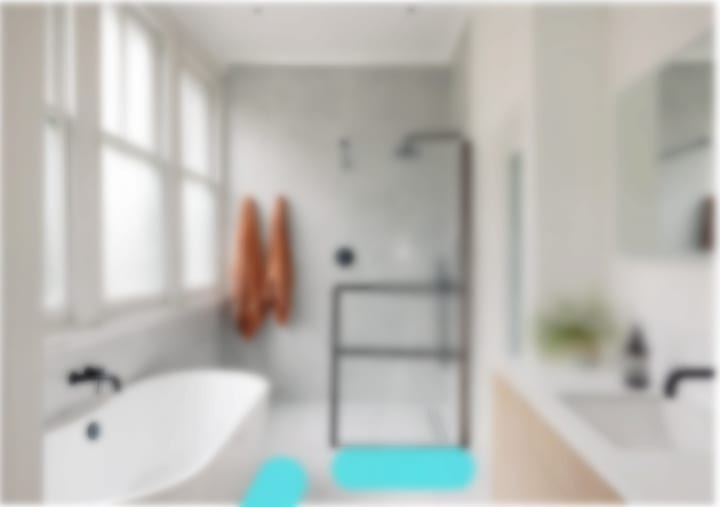
Much better isn't it?
6. Hallways
Many hallways are overlooked for adaptations because they are not technically considered rooms. However, there are several things that can be done in hallways to assist people with vision loss.
- Install motion-sensor ceiling lights to turn on automatically when you walk down the hallway, lighting the path without having to fumble for a switch.
- Learn the trailing technique that guides you as you walk down hallways. It helps keep you moving in a straight line and identify doorways.
- Keep hallways free of clutter, as they can easily become a tripping hazard.
- Mark the edges of steps with bright tape or tactile edging to make them more visible and easier to detect.
7. Technology
Many different types of adaptive equipment are offered by agencies and companies to help with vision loss, but many things can be accomplished on your phone and computer.
Here is a list of adaptive equipment for vision loss, along with phone or computer alternatives:
Adaptive equipment vs. Phone or Computer
1. Talking alarm clock - Alarm with voiceover
2. Magnifying glass - Magnification feature
3. Braille display - Screen reader software
4. Electronic magnifier - Magnification feature
5. Closed-circuit television - Magnification feature
6. Portable notetaker - Note-taking app
7. Color identifier - Color identification app
8. Object identifier - Identification app (Google Lens)
Phones and computers have many built-in accessibility features such as screen readers, changing font sizes, high-contrast themes, magnification, and color modes.
There are some more adaptive apps that are free:
- Be My Eyes - volunteers help see things for you such as "I dropped my earring".
- Seeing Ai (iOS) & Lookout (Android) are Ai assistants to help identify objects, text, and people around you.
- BlindSquare - a GPS app that provides information about nearby points of interest and helps users navigate their surroundings.
- BigLauncher - An Android app that simplifies the smartphone's interface making it easier to see.
- Always ask the person what they prefer to use.
- Never move things around without first asking or notifying them. Everything should have a place and be kept there for easy locating.
- Trial and error is necessary to find what works for each individual.
- Understand that the person is grieving. Vision loss is a major change and they may be questioning everything about themselves and their life.
- Do not do things for the person. Encourage independence, no matter how long it takes.
- Stop babying them. They are adults and should be respected.
To Wrap Things Up
Each person's vision loss and acceptance of it will vary. When adapting a home, it is important to keep the following pointers in mind:
If you would like more pointers in other areas, please read my ebook, where I share my experience.
About the Creator
Tracy Stine
Freelance Writer. ASL Teacher. Disability Advocate. Deafblind. Snarky.


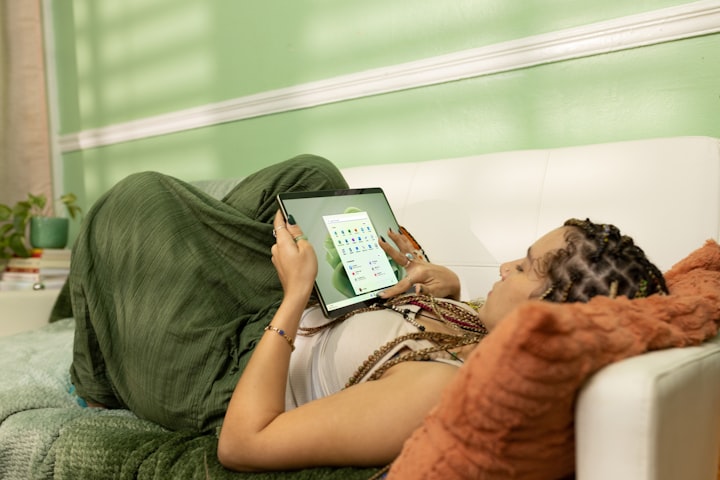



Comments (3)
Superbly written!!! This is a wealth of advice and information!!! Loved it!!!💕♥️♥️
Very interesting article, also check https://pearlmodapk.com/?s=family+island+mod+apk
I’ll adapt my home! Great job!